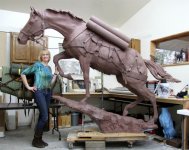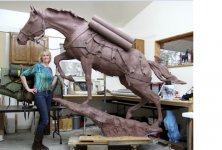BLReed
Sergeant Major
- Joined
- Nov 22, 2009
- Messages
- 1,676

Jeanne Toussaint/Art Castings - Colorado sculptor Jocelyn Russell created a statue
of the horse, Reckless, the statue will be dedicated Friday, from 12:45 to 3 p.m., at the National
Museum of the Marine Corps, 18900 Jefferson Davis Highway, Triangle, Virginia. .
This weekend marks the 60th anniversary of the Korean War Armistice, the day an agreement was signed to end the fighting in the peninsula now divided into North and South Korea. On Saturday, men and women who fought in Korea will be honored in Washington. But the day before, another kind of leatherneck (a nickname for a Marine) will be honored: a little red horse.
Her name was Sergeant Reckless, and the Marines “drafted” her to pack ammunition to the battlefield and carry the wounded back to safety. But here’s the thing: She did it on her own. She kept climbing those jagged hills even after she was wounded.
A little mare that carried ammunition during the Korean War is honored with a statue at the Marine Corps Muesum.
The soldiers came to love her so much that they brought her home from Korea after the war to live at Camp Pendleton in California. On Friday, “Operation Reckless” at the National Museum of the Marine Corps in Quantico will feature the unveiling of a life-size statue of Sergeant Reckless, a real war horse.
“She was one of them, and that’s why they’re honoring her,” said Robin Hutton, of Ventura, California, who has written a book on the mare to be published this year. “She wasn’t a horse; she was a Marine.”
You might think that Sergeant Reckless was the inspiration for last year’s movie “War Horse.” But that was based on a children’s fiction book about an English farm horse on the front lines of World War I.
The story of Sergeant Reckless is just as epic, and all true. Lieutenant Colonel Andrew Geer, a Marine who served alongside Reckless, became her first biographer. As he wrote in “Reckless: Pride of the Marines”: “Some war stories become dated, but in the case of Reckless, there was no such worry. Her story is as timeless as that of Black Beauty.”
She was stabled at a Seoul racetrack when the Korean War broke out in 1950. Known then as Flame, she helped her owners flee to the countryside. Geer wrote that Flame was sold to the Marines to help the family pay medical bills. She was renamed by the Recoilless Rifle Platoon of the 5th Marines, her new home.
Reckless was a quick study. She learned to step over communication wires, lie down on command and kneel. Her main caretaker, Sergeant Joseph Latham, said, “Tell her what you want and let her look the situation over and she’ll do it, if she’s with someone she trusts.”
At the same time, Reckless began to endear herself to her platoon, Geer wrote. She was lavished with attention. On cold nights, she could be found dozing by the stove-heater in Latham’s tent. Her appetite was legendary, too. She devoured carrots and apples, but also loved candy bars, Wheaties and Coca-Cola.
But when the going got tough, Reckless did, too. After Marines led her a few times up and down to battle stations, she remembered the way and traveled the route by herself. During one battle in March 1953, she made 51 trips from an ammunition supply depot to the front line, carrying more than 9,000 pounds of explosives.
“As long as I live, I will never forget that image of Reckless against the skyline, her silhouette in the flare lights,” said Harold Wadley, now 79, by phone from his ranch in St. Maries, Idaho. “It was just unbelievable, in all that intense fire, in the middle of this chaos. I said, ‘Dadgum, that’s that mare!’ ”
Wadley will be among the Korean War veterans who served with Reckless attending the dedication. The event will represent a goal achieved for Hutton, who commissioned the statue and hopes to install a replica at Camp Pendleton. “I’d like to see statues of this little horse everywhere,” she said. “What she did was amazing.”
— Kay Coyte


